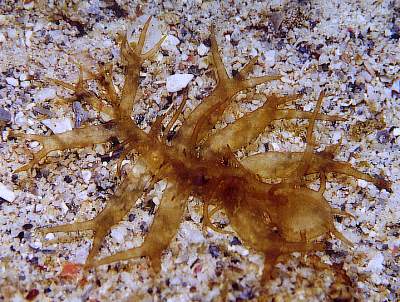
Melibe megaceras
Gosliner, 1987
Order: NUDIBRANCHIA
Suborder: DENDRONOTINA
Family: Tethydidae
DISTRIBUTION
Known from Hawaii, Malaysia, & Great Barrier Reef. Probably widespread at least in tropical Pacific.
PHOTO
Mantanani Is, near Kota Kinabalu, Sabah, Malaysia. In 24m depth [19-24 March, 2003] Photos: Harry Erhardt
The whole animal appears translucent brown, the colour coming from microscopic algae [zooxanthellae] living in the body, and which can be seen through the transparent body wall. Some animals can have opaque whitish spots on the ceratal wall and along the edge of the foot [see photo in separate message].
Like all species of Melibe there is a large oral hood which is used in the capture of its food - small crustacea. There are also large cerata down each side of the body. As its name megaceras implies, the cerata are extremely large, or at least greatly elongated, in this species and at the tip there are two or three long pointed papillae. All over the dorsal surface, the sides of the body, and the oral hood, are long tapering unbranched papillae. [see message 1 and message 2 for close-up photos showing these structures in greater detail]. All species of Melibe are rather strange in shape, but this must be the strangest of all. It reaches at least 70mm in length.
Gosliner (1987) reports that this species is found on shallow water sandflats in Hawaii and suggests that it may be seasonally abundant. He describes how it holds the cerata out horizontally when it is crawling along, so that it is 'exeedingly flat'. It translucent brown colour, and its flat aspect, make it almost invisible on a white sandy bottom. Steve Kempf (1984) found small crustacean remains in its faeces, and fed it brine shrimp in captivity, confirming that it is a feeder on small crustacea. He also observed it swimming by lateral flexion of the whole body. The egg mass is a white coiled ribbon attached to the sand by a mucous thread.
Kempf (1984) studied the symbiotic relationship between Melibe megaceras and its symbiotic zooxanthellae Symbiodinium microadriaticum. This symbiosis appears to be an intermediate step on the way to some of the truly solar-powered symbioses I describe elsewhere in the Forum. We are not sure how M. megaceras obtains its zooxanthellae, as they are not present in the eggs or embryo, and its does not feed on an organism already containing zooxanthellae. Kempf suggests that it must obtain them either during the veliger stage, when it is an phytoplankton feeder, or just after metamorphosis, when it may feed on something which has zooxanthellae. M. megaceras does not appear to be able to 'milk' the living zooxanthellae of their photosynthetic products, and so must regularly kill and partially digest some of its symbiont zooxanthellae to obtain access to the products of algal photosynthesis. I can only assume that the behaviour of holding the cerata out flat when crawling around is a behaviour evolved to favour the symbiotic algae in its cerata and body wall - giving them maximum access to available sunlight.
Reference:
• Gosliner, T.M. (1987) Review of the nudibranch genus Melibe (Opisthobranchia: Dendronotacea) with descriptions of two new species. The Veliger, 29(4): 400-414.
• Kempf, S. C. 1984. Symbiosis between the zooxanthella Symbiodinium (=Gymnodinium) microadriaticum (Freudenthal) and four species of nudibranchs. Biological Bulletin, 166(1): 110-126.
Rudman, W.B., 2003 (April 14) Melibe megaceras Gosliner, 1987. [In] Sea Slug Forum. Australian Museum, Sydney. Available from http://www.seaslugforum.net/find/melimega
Related messages
Re: Melibe megaceras from Red Sea
March 15, 2005
From: Bill Rudman
Since writing my comment of Oren Lederman's find of Melibe megaceras from the Red Sea [#13309] I have found two earlier records of this species from the Red Sea but identified as Melibe bucephala Bergh 1902.
Schuhmacher (1973) reports on the feeding and swimming behaviour of this animal as Melibe bucephala from Eilat, [Israel, Gulf of Aquaba, Red Sea] and Yonow (2000) publishes a photo and records specimens also from Eilat. Schumacher observed it feeding by closing its oral hood over algal filaments and wiping them clean.
It is difficult to be sure what Melibe bucephala is. Bergh described it on the basis of a single preserved animal from Thailand, in which most of the cerata had neem lost. No illustration is available of the living animal. In Gosliner's revision (1987) he lists some distinguishing features including rhinophore sheath - flattened and leaflike in M. bucephala and with a long posterior papilla in M. megaceras. The oral hood of M. bucephala has 5 rows of papillae but there are only two in M. megaceras. Also bergh describes jaw plates in M. bucephala while in M. megaceras. they are absent. Both Schuhmacher's and Yonow's photos match M. megaceras. Schuhmacher reports that his animal had 2 rows of papillae on the oral hood, and small mandibles, which are reported to be absent in M. megaceras. However it is not clear if Schuhmacher was actually reporting on specimens he had dissected or was basing his statement on Bergh's description of M. bucephala.
At this stage I would identify your animal as M. megaceras. There is no sure way of confidently re-identifying Bergh's M. bucephala.
-
Bergh, L.S.R. (1902) The Danish Expedition to Siam 1899-1900. 1. Gasteropoda Opisthobranchiata. Det Kongelige Danske Videnskabernes Selskabs Skrifter. 6 Raekke. 12(2): 153-218. (Pls.1-3)
-
Schuhmacher, H. (1973) Notes on occurrence, feeding, and swimming behaviour of Notarchus indicus and Melibe bucephala at Elat, Red Sea (Mollusca: Opisthobranchia). Israel Journal of Zoology, 22: 13-25.
-
Yonow, N. (2000) Red Sea Opisthobranchia 4: The orders Cephalaspidea, Anaspidea, Notaspidea and Nudibranchia: Dendronotacea and Aeolidacea. Fauna of Arabia, 18: 87-131.
Bill Rudman
Rudman, W.B., 2005 (Mar 15) Re: Melibe megaceras from Red Sea. [Message in] Sea Slug Forum. Australian Museum, Sydney. Available from http://www.seaslugforum.net/find/13326Melibe megaceras from the Red Sea
March 12, 2005
From: Oren Lederman
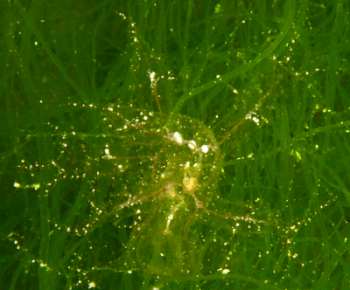
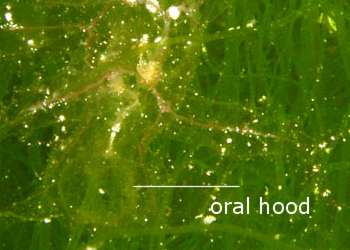
Hi Bill,
Weird looking, ummm, something :-)
I wasn't sure whether this one is a seaslug, but I decided to post it anyway. My dive buddy found it moving on the seagrass at the dive site, and it looked like it was feeding on the sea grass. It was almost transparent, making it very hard to photograph.
Locality: Near the "Yethush" shipwreck, Eilat Bay, Israel, Red Sea. Depth: ~22 m. Length: about 4 x 4 cm. 18 Feb 2005. sea grass ? tangled filamentous algae ? Photographer: Oren Lederman
Oren Lederman
lederman@bigmail.co.il
Lederman, O., 2005 (Mar 12) Melibe megaceras from the Red Sea. [Message in] Sea Slug Forum. Australian Museum, Sydney. Available from http://www.seaslugforum.net/find/13309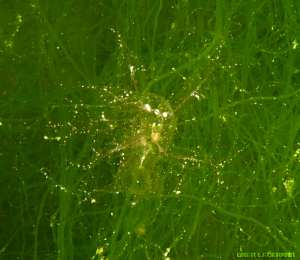
Dear Oren,
You had every right to be puzzled by this interesting animal. It is indeed a nudibranch, and although difficult to make out the details, I am pretty sure it is Melibe megaceras, a species only known from the western Pacific. So this is a big range extension. It is a bit difficult to see the animal so I have posted a number of enlargements. In one of them I have labelled the oral hood, so typical of species of Melibe and the related Tethys
Best wishes,
Bill Rudman
Melibe megaceras from the Great Barrier Reef
May 6, 2003
From: Bill Rudman


In an earlier message I mentioned that I possibly had photos of Melibe megaceras from the Great Barrier Reef, QLD, Australia.
The animals were photographed crawling on aquarium glass so are ventral shots. The lower closeup of ceratashows the brown specks which are symbiotic zooxanthellae
No further information accompanies the photos. Lizard Id, Great Barrier Reef. Sept 1978. AM C112516. Photo: Barry Goldman.
Best wishes,
Bill Rudman
Melibe megaceras from Malaysia
April 17, 2003
From: Harry Erhardt
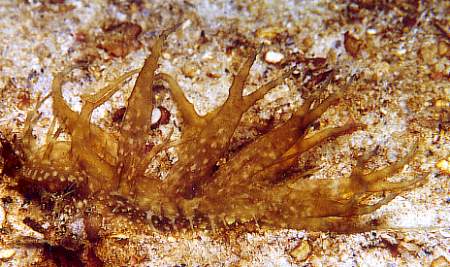

Dear Bill,
I have just returned from the island of
Mantanani, a small island near Kota Kinabalu, Sabah, Malaysia. In 24m depth [19-24 March] I found a big population of hundreds of animals of a species of Melibe I have never seen in my life before and not in the Sea Slug Forum. They ranged in length from 30 mm to about 70 mm.
Here are some photos to show you that these animals exist. A friend of mine has a video of these creatures if you need more information on their feeding and moving actions. I think that this Melibe is now at a reproductive stage, because you only see so many animals coming together when they are forming breeding aggregations.
Gilly Elliott, who is dive master at Mantanani, and is very interested in nudibranchs could also give you further information.
Dr Harry Erhardt
Fritzlar
Germany
dr.harry.erhardt@web.de
Erhardt, H., 2003 (Apr 17) Melibe megaceras from Malaysia. [Message in] Sea Slug Forum. Australian Museum, Sydney. Available from http://www.seaslugforum.net/find/9655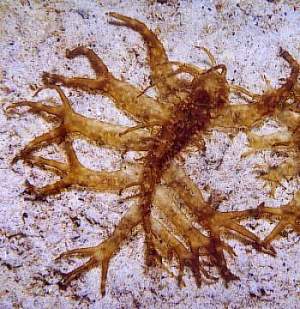
Dear Harry,
Thanks for these wonderful photos of the Melibe. It is Melibe megaceras which has previously been recorded only from Hawaii. It isn't on the Forum because I didn't have any reasonable photos of it. I think it was photographed many years ago at Lizard Is, Great Barrier Reef, but will need to hunt through my old correspondence files to see if I can find the photos - a daunting task. I have prepared a Fact Sheet on the species, and split your photos into a few messages so we can display some of its anatomy in sufficient detail. The upper right photo shows a larger animal with whitish patches on the cerata and the sides of the foot.
Basically this is one of the strangest looking of a very strange-looking genus! I would suspect the very large cerata and the way they are held horizontally, are related to its zooxanthellae symbiosis whih I discuss on the Fact Sheet. To keep zooxanthellae alive and functioning, they have to have sunlight. By keeping the cerata flattened it allows the whole surface of each ceras to be in the sun, and also the upper surface of the body and the oral hood, both of which are also full of zooxanthellae.
Like all species of Melibe, this animal species has that unique feeding organ - or dishing net - the oral hood. It has papillae around the 'lip' of the hood which are used to sense small crustacea iin the sand. I have posted some close-up photos of the head region in a separate message.
Rudman, W.B., 2003 (Apr 17). Comment on Melibe megaceras from Malaysia by Harry Erhardt. [Message in] Sea Slug Forum. Australian Museum, Sydney. Available from http://www.seaslugforum.net/find/9655Melibe megaceras - detail of the head
April 17, 2003
From: Bill Rudman
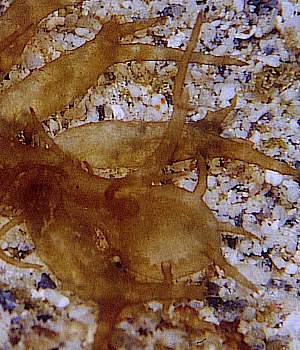
Here are three enlargements from Harry Erhardt's photos of Melibe megaceras to show the detail of the head and associated structures.
Mantanani Is, near Kota Kinabalu, Sabah, Malaysia. In 24m depth [19-24 March, 2003] Photos: Harry Erhardt
Upper Right: In this dorsal shot of the head, the shadowy outline of the sensory tentacles around the lip of the oral hood can be seen through the transparent skin. These tentacles are constantly moving 'feeling' over the surface of the sand as the animal crawls along, trying to locate the small crustacea it feeds on. The brown specks which can be seen all over the skin are clusters of the symbiotic zooxanthellae I describe on the Fact Sheet. On the dorsal surface of the oral hood are a series of long tapering papillae which are attached some distane in from the edge. I have no idea whether they have a special sensory purpose. I rather suspect that, like the ones all over the back, they are just another place to 'farm' zooxanthellae. Also on the oral hood are a pair of rhinophores, the nudibranch chemosensory organ. In this photo we can only see the left rhinophore. It is the structure that runs from the oral hood up to the top of the photo. The slightly curved, and thicker, bottom half of this structure is the rhinophore stalk, or more correctly the rhinophore sheath. At the top of the sheath sits the very small, pointed, rhinophore club, and behind it is a long thin tapering flagellum.
Lower Photos: These photos show the same structures from different angles. In particular, the left photo shows the dorsal tentacles on the oral hood standing upright, and they show the rhinophore stalk/sheath and the posterior flagellum a little more clearly. The flagellae have small pointed papillae scattered over them. Both these photo show animals with some whitish patching on the body.
Best wishes,
Bill Rudman
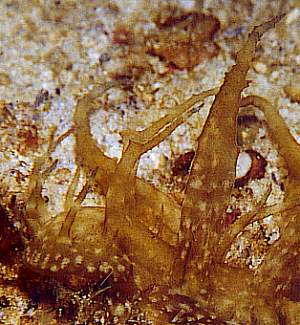
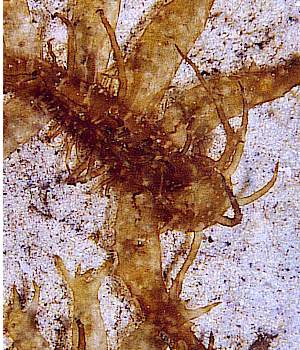
Melibe megaceras from Malaysia (2)
April 17, 2003
From: Harry Erhardt
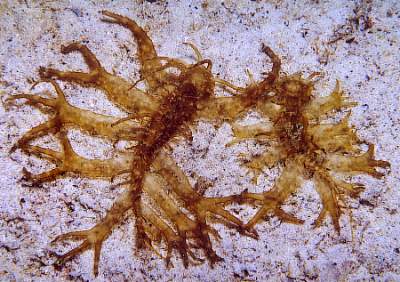
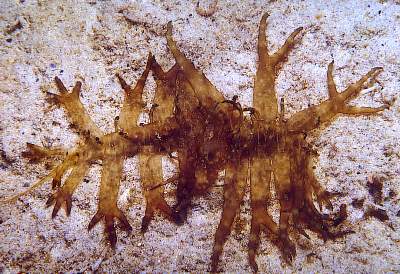
Dear Bill,
To acompany my other message here are some photos of Melibe together.
Mantanani Is, near Kota Kinabalu, Sabah, Malaysia. In 24m depth [19-24 March, 2003] Photos: Harry Erhardt
There were hundreds of animals and many were together. I suspect the pair in the lower photo are mating. As I said in my earlier message I think that this Melibe is now at a reproductive stage, because usually you only see so many animals coming together when they are forming breeding aggregations.
Dr Harry Erhardt
Fritzlar
Germany
dr.harry.erhardt@web.de
Erhardt, H., 2003 (Apr 17) Melibe megaceras from Malaysia (2). [Message in] Sea Slug Forum. Australian Museum, Sydney. Available from http://www.seaslugforum.net/find/9678Thanks again Harry,
Yes I think the pair in the bottom photo are probably mating. In Melibe the common genital opening is on the right side near the head, so for mating they need to get into this tête à tête position. You are probably correct that they are at a breeding stage in their life cycle. Terry Gosliner suggested that they may have a similar synchronous cycle in Hawaii. What we don't know is if they migrate to 'breeding grounds' when they mature, or whether they stay at the same locality all their lives and only become obvious when they are big and breeding. Have a look at the Mass Mortality page for further discussion on this topic.
Best wishes,
Bill Rudman
Melibe megaceras - anatomical details
April 17, 2003
From: Bill Rudman
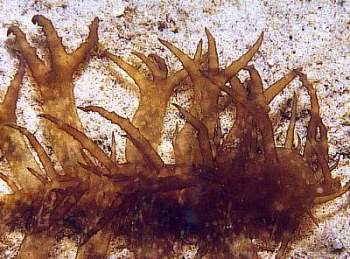
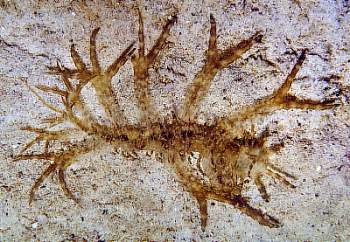
Here are some more close-ups from Harry Erhrdt's photos of Melibe megaceras from Malaysia.
Mantanani Is, near Kota Kinabalu, Sabah, Malaysia. In 24m depth [19-24 March, 2003] Photos: Harry Erhardt
The upper photo shows the papillae on the back. It seems the larger of them, like the flagellum on the rhinophore sheath, has scattered raised points. The lower photo shows an animal crawling on the sand with it erata flattened out. On the right side of the animal some of the cerata are missing. This is quite a common occurrence in Melibe, and often half-grown replacement cerata are present. Species of Melibe, like many other nudibranchs, are able to break off cerata, or other parts of their body, when they are 'stressed'. This phenomenon is called autotomy, and is considered a defensive strategy.
Best wishes,
Bill Rudman
